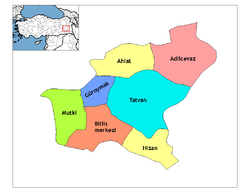Bitlis
Bitlis (Armenian: Բաղեշ Baghesh/Paghesh;[3] Kurdish: Bidlîs[4]; Ottoman Turkish: بتليس; Medieval Greek: Βαλαλης Balales) is a city in eastern Turkey and the capital of Bitlis Province. The city is located at an elevation of 1,545 metres, 15 km from Lake Van, in the steep-sided valley of the Bitlis River, a tributary of the Tigris. The local economy is mainly based on agricultural products which include fruits, grain and tobacco. Industry is fairly limited, and deals mainly with leatherworking, manufacture of tobacco products as well as weaving and dyeing of coarse cloth. Bitlis is connected to other urban centres by road, including Tatvan on Lake Van, 25 km to the northeast, and the cities of Muş (Mush), 100 km northwest, and Diyarbakır, 200 km to the west. The climate of Bitlis can be harsh, with long winters and heavy snowfalls. Summers are hot, and often humid. Since the local elections of March 2019, the Mayor of Bitlis is Nesrullah Tanğlay.[5]
Bitlis | |
|---|---|
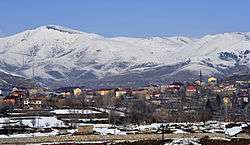 Bitlis Views | |
 Bitlis | |
| Coordinates: 38°24′00″N 42°06′30″E | |
| Country | Turkey |
| Province | Bitlis |
| Government | |
| • Mayor | Nesrullah Tanğlay (AKP) |
| • Governor | Oktay Çağatay |
| Area | |
| • District | 1,128.14 km2 (435.58 sq mi) |
| Elevation | 1,545 m (5,069 ft) |
| Population (2012)[2] | |
| • Urban | 46,111 |
| • District | 64,725 |
| • District density | 57/km2 (150/sq mi) |
| Website | https://www.bitlis.bel.tr/ http://www.bitlis.gov.tr/ |
History
Ancient and medieval
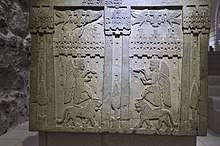
The origin of the name Bitlis is not known. A popular folk etymology explanation, without historical basis, is that it is derived from "Lis/Batlis", the name of a general said to have built Bitlis castle by the order of Alexander the Great.[6] To Armenians, it was known as Balalesa or Baghaghesh, and later Baghesh.[7] According to one popular Armenian folk story, on a cold, wintry day a donkey left its stable and wandered down the valley below. The donkey died of the freezing temperatures and was only discovered in the spring, once the ice had melted; thus, it received the name Pagh Esh, or "Cold Donkey."[8]
Baghesh was one of the most important cities of the Kingdom of Armenia's province of Aghdznik', and it served as the primary fortress of the province's canton of Salnodzor.[6] Some medieval Armenian writers, such as Anania Shirakatsi and Vardan Areveltsi, later mention it as a part of the canton of Bznunik'.[6] The fortress guarded the Baghesh Pass, which linked the southern reaches of the Armenian Plateau to northern Mesopotamia. The Arabs conquered Baghesh at the end of the seventh century and it eventually became the capital of the Zurārid emirs of Arzan. Because it was on an important trade route, it prospered greatly.
The next two centuries, however, marked a turbulent period in the town's history. After Bugha al-Kabir's destructive 852-855 campaign in Armenia, the Shaybanid emirs wrested control of Baghesh from the Zurārids;[9] thereafter, in the first quarter of the tenth century, it was taken by the Kaysite emirs of Manzikert. In his 929-30 campaign against the Kaysites, the Byzantine general John Curcuas was able to capture and annex Baghesh.[6] Following the devastation of the Arab emirs in the second half of the tenth century, a great number of Kurds settled in Baghesh and at the end of the tenth century, the city fell into the hands of the Kurdish Marwanid dynasty after breaking from Buyid rule.[6] At the end of the eleventh century, with the collapse of Byzantine power after the Battle of Manzikert, Bitlis fell under the control of Togan Arslan, a subject of the Shah Arman (Also called Ahlatshah) dynasty based in Akhlat' after brief Dilmachoglu rule. It was also ruled by Ayyubid (1207–1231), Khwarezm Shahs (shortly rule in 1230), Sultanate of Rûm (1231–1243) and Ilkhanate (1243–1335).
Emirate
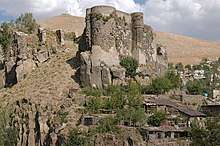
Bitlis was a Kurdish emirate from the 13th to the 19th century. Though often subordinate to a succession of larger powers that ruled the Van region, it always maintained a measure of independence. In the 14th century its emirs, the Kurdish Rusaki family, were vassals of the Karakoyunlu and the emirate's territory also consisted of several smaller emirates: Ahlat, Mush, and Hinis. The emir of Bitlis submitted to Timur in 1394, but later helped the re-establishment of Karakoyunlu control in the region. After the collapse of the Karakoyunlu state, the Bitlis emirate disintegrated. However, in the 1470s it took the Aq Qoyunlu (White Sheep Turkomans) three successive sieges to capture Bitlis and in 1494/95 the Ruzaki recaptured the town.[6] Armenians formed a large part of the city's population. A number of monasteries were permitted to be built by the Kurdish emirs and during the fifteenth century, Biltis flourished as a center for Armenian manuscript production.
Bitlis was forced to accept a Persian governor during the invasion of the Safavid Shah Ismail, but sided with the Ottoman forces as they approached the region. Its emir, Sheref, later changed his allegiance to the Persians. An Ottoman army besieged Bitlis for three months in 1531/32, but was forced to retire. Sheref was killed in battle in 1533 and his son and successor submitted to the Ottoman Empire. Mush and Hınıs were removed from the Bitlis emirate, becoming separate sanjaks but still with Ruzaki beys. A Jesuit mission was established in Bitlis in 1685. The Ruzakid Kurdish dynasty in Bitlis lasted until 1849, when an Ottoman governor evicted its last emir, Sheref Bey, who was taken to Constantinople as a prisoner. After this, Bitlis was governed by a Turkish pasha and formed the capital of a vilayet bearing its name.[10]
Modern
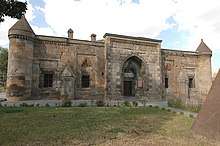
In 1814 the population of Bitlis town was said to be 12,000 people - one half Muslim, the other half was constituted by Christian Armenians. By 1838 its population was said to be between 15,000 and 18,000 - two thirds Muslim, one third Armenian, and a small minority of Assyrians. In 1898 Lynch considered the population to be close to 30,000, comprising 10,000 Armenians, 300 [As]syrians, and the rest Muslim Kurds (both Alevis and Sunnis included).[11] The Armenians had five schools for boys and three for girls.[6] One third of the population of Bitlis was ethnic Armenian prior to World War I (1914, whereas the majority of the population was Kurdish Muslim (Alevi as well as Sunni Muslims). In 1915, during the Armenian Genocide, Turks and Kurds, led by Jevdet Bey Pasha, massacred some 15,000 Armenians in Bitlis.[12]
In February 1916, as part of the Caucasus Campaign, Imperial Russian forces launched an offensive to capture Mush and Bitlis. Mush fell on February 16. At Bitlis, the Turkish positions were in a strong location on the outskirts of the town and could not be outflanked because of the narrowness of the valley. On the night of March 2–3, during a blizzard, the Russian 8th Caucasian Rifles advanced silently and, after several hours of hand-to-hand fighting, took the Turkish positions with 1,000 prisoners. The Turks then abandoned Bitlis, retreating towards Siirt. The Russian forces and intelligence officers found evidence of the massacres of Christians by the Kurdish and Turkish radicals in 1915.
In August 1916 the Turkish Second Army started an offensive against the Russian front in eastern Turkey. On August 2, the Ottoman 16th Corps, together with strong Kurdish irregulars' support, attacked Bitlis and Mush.[13] Fearing encirclement General Nazarbekov, the Russian commander, abandoned Bitlis on August 5.[13] When Mush also fell, he decided to abandon Tatvan and the whole Mush valley and retreat to Ahlat.[13] Around 18 August, the Russians having been reinforced, were able to counter-attack.[14] By September the Turkish offensive was stalled and then turned. Nazarbekov advanced as the Turkish forces withdrew from Tatvan and Mush,[14] but he did not have the available forces to hold Bitlis as winter approached. The Russian February Revolution in the spring of 1917 prevented any further Russian gains.[15]
Description
Bitlis preserves more medieval and traditional architecture than any other town in eastern Turkey. They are of a high quality and are mostly constructed from locally quarried light-brown stone, sometimes called Ahlat stone.
The town contains a large number of late-medieval Islamic buildings in the form of mosques, madrassas, and tombs. Also commercial buildings such as "Han's Caravanserais. Commissioned mostly by its local Kurdish rulers, the architectural style of these buildings is very conservative and similar to much earlier Seljuq-period structures. Important monuments include the 12th-century Ulu Mosque with its 15th-century minaret, and the Gokmeydani Medresesi and Sherefiye Mosque from the sixteenth century. Until 1915 there were five Armenian monasteries and several churches in Bitlis – only a 19th-century Armenian church survives, now used as a warehouse.[16]
Bitlis is also notable for its many old houses. These are built of cut stone and are often large and impressive structures. Most have two stories, but three stories are also found. Ground floors were generally intended for storage and stables, with the residential quarters on the upper floors. Ground floor rooms have few windows, upper floors are well lit. Roofs are flat and covered with beaten clay. Unlike traditional houses in nearby Erzurum or Van, Bitlis houses do not have bay windows and balconies.[17]
Gallery
 Bitlis Castle (Bitlis Kalesi)
Bitlis Castle (Bitlis Kalesi) Ulu Cami text
Ulu Cami text Bitlis Şerefiye Mosque
Bitlis Şerefiye Mosque Ihasiye Şerafhan Medresesi view of türbes
Ihasiye Şerafhan Medresesi view of türbes
Climate
Bitlis has a dry-summer continental climate according to the (Köppen climate classification Dsa). Bitlis has very warm, dry summers and freezing, snowy winters.
| Climate data for Bitlis (1960-2012) | |||||||||||||
|---|---|---|---|---|---|---|---|---|---|---|---|---|---|
| Month | Jan | Feb | Mar | Apr | May | Jun | Jul | Aug | Sep | Oct | Nov | Dec | Year |
| Record high °C (°F) | 15.1 (59.2) |
13.2 (55.8) |
23.0 (73.4) |
27.8 (82.0) |
29.4 (84.9) |
34.0 (93.2) |
38.0 (100.4) |
37.4 (99.3) |
35.5 (95.9) |
30.2 (86.4) |
22.0 (71.6) |
15.6 (60.1) |
38.0 (100.4) |
| Average high °C (°F) | 1.2 (34.2) |
2.3 (36.1) |
6.2 (43.2) |
12.8 (55.0) |
19.3 (66.7) |
25.5 (77.9) |
30.5 (86.9) |
30.8 (87.4) |
26.4 (79.5) |
18.6 (65.5) |
10.4 (50.7) |
3.4 (38.1) |
15.6 (60.1) |
| Daily mean °C (°F) | −2.9 (26.8) |
−2.1 (28.2) |
1.7 (35.1) |
7.6 (45.7) |
13.2 (55.8) |
18.5 (65.3) |
22.8 (73.0) |
22.3 (72.1) |
17.6 (63.7) |
11.3 (52.3) |
4.7 (40.5) |
−0.8 (30.6) |
9.5 (49.1) |
| Average low °C (°F) | −6.4 (20.5) |
−5.7 (21.7) |
−2.0 (28.4) |
3.2 (37.8) |
7.3 (45.1) |
11.5 (52.7) |
15.6 (60.1) |
15.0 (59.0) |
10.8 (51.4) |
6.3 (43.3) |
0.9 (33.6) |
−4.1 (24.6) |
4.4 (39.9) |
| Record low °C (°F) | −21.3 (−6.3) |
−22.0 (−7.6) |
−20.3 (−4.5) |
−12.0 (10.4) |
−2.5 (27.5) |
1.9 (35.4) |
7.0 (44.6) |
7.0 (44.6) |
1.8 (35.2) |
−6.0 (21.2) |
−17.0 (1.4) |
−21.9 (−7.4) |
−22.0 (−7.6) |
| Average precipitation mm (inches) | 148.6 (5.85) |
176.6 (6.95) |
167.7 (6.60) |
167.8 (6.61) |
97.6 (3.84) |
22.8 (0.90) |
5.7 (0.22) |
4.2 (0.17) |
17.0 (0.67) |
89.8 (3.54) |
146.7 (5.78) |
156.7 (6.17) |
1,201.2 (47.3) |
| Average precipitation days | 13.6 | 13.4 | 15.4 | 15.9 | 14.2 | 5.9 | 2.4 | 2.3 | 3.5 | 10.2 | 11.1 | 13.2 | 121.1 |
| Mean monthly sunshine hours | 74.4 | 92.4 | 155.0 | 177.0 | 229.4 | 279.0 | 303.8 | 300.7 | 276.0 | 167.4 | 87.0 | 62.0 | 2,204.1 |
| Source: Devlet Meteoroloji İşleri Genel Müdürlüğü[18] | |||||||||||||
Economy
Historically, Bitlis produced wheat, which the British, in 1920, described as being "particularly excellent." However, poor trade routes in the area during the early 20th century meant that the wheat was mainly produced and used by locals. During this time, the British stated that the people of Bitlis were unable to use all of the wheat they produced, and most was "left to rot in the underground storehouses."[19]
Notable individuals
- Arakel Paghishetsi (1380-1454) Armenian musician, hymnologist
- Hovhannes Paghishetsi (1678-1741) 49th Armenian patriarch of Constantinople
- Vardan Paghishetsi (???-1705) Armenian chronographer
- Vardan Paghishetsi (16th century) Armenian medieval illuminator
The city was the home of the sixteenth century Kurdish historian, Sherefxan Bedlisi (also: Sharaf al-Din Bitlisi), author of the Sharafnameh, and who was also an appointed prince of the Persian and later Ottoman Empires.
Ottoman administrator and Kurdish religious scholar and author Idris-i Bitlisi is claimed to have been born in Bitlis also. He was instrumental in conquest, Ottomanization and administration of Ottoman lands from Urfa, Mardin to Egypt.
Said Nursi (Nurs, Bitlis, 1877) notable Kurdish Sunni Muslim Theologian. Writer of the Risale-i-Nur collection used as the foundation of movements such as the Nurcu in Turkey and the Gulenist movement founded by Fetullah Gulen.
Fuat Sezgin (Bitlis, 1924), a prominent Historian of Science, Orientalist was born in Bitlis. He is the author and editor of numerous publications. His 13-volume work Geschichte des Arabischen Schrifttums (1967-2000) is the cornerstone reference on the history of science and technology in the Islamic world. The 5-volume Natural Sciences of Islam documents the items in the Frankfurt museum. Since 1984 he has edited the Journal for the History of Arabic-Islamic Science.
American writer William Saroyan's parents were immigrants from Bitlis to Fresno, California. He wrote a play entitled "Bitlis" about his "return" to the city he considered his homeland, which he actually did visit in later years.[20]
Kâmran İnan (Hizan, Bitlis, 1929), a well known Turkish politician, diplomat, and scholar was from Bitlis. He has written about the history of Bitlis.
International relations
Notes
- "Area of regions (including lakes), km²". Regional Statistics Database. Turkish Statistical Institute. 2002. Retrieved 2013-03-05.
- "Population of province/district centers and towns/villages by districts - 2012". Address Based Population Registration System (ABPRS) Database. Turkish Statistical Institute. Retrieved 2013-02-27.
- Hakobyan, Tadevos (1987). Պատմական Հայաստանի քաղաքները [Cites of historic Armenia] (in Armenian). Yerevan: "Hayastan" Publishing. p. 98.
- Adem Avcıkıran (2009). Kürtçe Anamnez Anamneza bi Kurmancî (PDF) (in Turkish and Kurdish). p. 55. Retrieved 17 December 2019.
- "Bitlis Seçim Sonuçları - 31 Mart 2019 Yerel Seçimleri". www.sabah.com.tr. Retrieved 2020-04-09.
- (in Armenian) Anon. «Բաղեշ» [Baghesh]. Armenian Soviet Encyclopedia. Yerevan: Armenian Academy of Sciences, 1976, vol. ii, pp. 254-256.
- Hewsen, Robert H. "The Historical Geography of Baghesh/Bitlis and Taron/Mush" in Armenian Baghesh/Bitlis and Taron/Mush. Richard G. Hovannisian (ed.) UCLA Armenian History and Culture Series: Historic Armenian Cities and Provinces, 2. Costa Mesa, California: Mazda Publishers, 2001, p. 52.
- Ghanalanyan, Aram (1969). Ավանդապատում [Traditional Tales] (in Armenian). Yerevan: Manuk Abeghyan Institute of Literature. p. 160.
- Ter-Ghevondyan, Aram N. (1965). Արաբական Ամիրայությունները Բագրատունյաց Հայաստանում [The Arab Emirates in Bagratuni Armenia] (in Armenian). Yerevan: Armenian Academy of Sciences. p. 104.
- Sinclair, Thomas A (1987). Eastern Turkey: An Architectural and Archaeological Survey, Volume 1. London: Pindar Press. pp. 330–336. ISBN 0-907132-32-4.
- Lynch, H.F.B. (1901). Armenia, Travels and Studies, Volume 2. London: Longmans. p. 151.
- Walker, Christopher J. "The End of Armenian Taron and Baghesh, 1914-1916" in Armenian Baghesh/Bitlis and Taron/Mush, pp. 191-206.
- William Edward David Allen, Paul Muratoff, Caucasian Battlefields: A History of the Wars on the Turco-Caucasian Border 1828-1921, (Cambridge University Press, 2010), 421-422.
- Edward J. Erickson, Ordered to Die:A History of the Ottoman Army in the First World War, (Greenwood Press, 2001), 133.
- Allen, William E.D.; Paul Muratoff (1953). Caucasian Battlefields. Cambridge: Cambridge University Press. pp. 438–439.
- Sinclair. Eastern Turkey, pp. 297-308.
- (in Turkish) Sayin, Y. Bitlis Evleri (The Homes in Bitlis). Ankara, 2001, pp. 43-44.
- "Archived copy". Archived from the original on 2011-04-30. Retrieved 2011-03-19.CS1 maint: archived copy as title (link)
- Prothero, W.G. (1920). Armenia and Kurdistan. London: H.M. Stationery Office. p. 60.
- Calonne, David Stephen. "The Mulberry-Scented Air of Baghesht: Saroyan's Quest for Bitlis" in Armenian Baghesh/Bitlis and Taron/Mush, pp. 207-223.
Further reading
- Hovannisian, Richard G. (ed.) Armenian Baghesh/Bitlis and Taron/Mush. UCLA Armenian History and Culture Series: Historic Armenian Cities and Provinces, 2. Costa Mesa, California: Mazda Publishers, 2001.
External links
| Wikimedia Commons has media related to Bitlis. |

- BitlisHaber13
- Governor's Office
- Bitlis Haber
- BitlisNews
- Bitlis Article on Armeniapedia.org. Bitlis' Armenian history, map and information.
